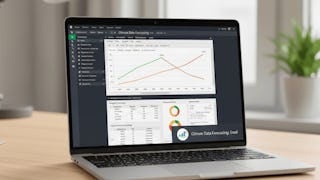This course explores different time series business forecasting methods. The course covers a variety of business forecasting methods for different types of components present in time series data — level, trending, and seasonal. We will learn about the theoretical methods and apply these methods to business data using Microsoft Excel. These forecasting methods will be programmed into Microsoft Excel, displayed graphically, and we will optimise these models to produce accurate forecasts. We will compare different models and their forecasts to decide which model best suits our business' needs.

Enjoy unlimited growth with a year of Coursera Plus for $199 (regularly $399). Save now.

Excel Time Series Models for Business Forecasting
This course is part of Excel Skills for Business Forecasting Specialization

Instructor: Assoc Prof Prashan S. M. Karunaratne
17,668 already enrolled
Included with
(246 reviews)
Skills you'll gain
Details to know

Add to your LinkedIn profile
19 assignments
See how employees at top companies are mastering in-demand skills

Build your subject-matter expertise
- Learn new concepts from industry experts
- Gain a foundational understanding of a subject or tool
- Develop job-relevant skills with hands-on projects
- Earn a shareable career certificate

There are 6 modules in this course
Business Forecasting is part of any and every organisation. Organisations need to forecast so that they can plan for the organisation’s needs. Business forecasts are the inputs to every organisation’s planning – without business forecasts we cannot plan for our resources, our production, our supply chains – and ultimately our costs, revenues and profits. The current state of the world makes business forecasting even more fundamental to the operation of institutions. In this course we focus on Excel Skills for Business Forecasting using Time Series Models. We will be looking at how your business can utilise time series data sets to understand the different components underlying this data, and then apply the relevant model depending on these components. We will look at a range of business forecasting methods, and sometimes, more than one method may be needed! The models we look at are: Naïve Forecasting, Moving Averages, Trend-fitting, Simple Exponential Smoothing, Holt’s Exponential Smoothing, Winters Exponential Smoothing, and Decomposition. This course then continues in our second course in this specialisation which looks at Regression Models, and our third course in this specialisation which looks at Judgmental Forecasting. #EveryoneSayWow
What's included
2 videos3 readings
In this module, we explore the context and purpose of business forecasting and the three types of business forecasting — time series, regression, and judgmental. This course focuses on time series models. We will learn about time series models, as well as the component of time series data. We will then look at a preliminary forecasting method — Average Forecasts. Once we have a forecast, we need a tool to judge the accuracy of the forecasts — which are the forecasts and the error criterion calculated from these.
What's included
4 videos4 readings3 assignments
In this module, we explore different time series forecasting methods available for data that is level.
What's included
5 videos2 readings5 assignments
In this module, we explore different time series forecasting methods available for data that is trending.
What's included
4 videos3 readings3 assignments
In this module, we explore a time series forecasting method (Winters Exponential Smoothing) available for data that is seasonal.
What's included
4 videos2 readings4 assignments
In this module, we explore a time series forecasting method (Decomposition) available for data that is seasonal.
What's included
4 videos2 readings4 assignments
Earn a career certificate
Add this credential to your LinkedIn profile, resume, or CV. Share it on social media and in your performance review.
Instructor

Offered by
Explore more from Business Strategy
 Status: Preview
Status: Preview Status: Free Trial
Status: Free TrialMacquarie University
 Status: Free Trial
Status: Free TrialMacquarie University
 Status: Free Trial
Status: Free TrialMacquarie University
Why people choose Coursera for their career




Learner reviews
246 reviews
- 5 stars
89.02%
- 4 stars
8.94%
- 3 stars
1.21%
- 2 stars
0.40%
- 1 star
0.40%
Showing 3 of 246
Reviewed on Mar 8, 2024
The course provided an excellent balance between practical application and theoretical understanding.
Reviewed on Apr 18, 2022
This is really good course. Every part of time series explained well. This is really helpful.
Reviewed on Nov 21, 2022
Great Skills thought. Thank you Prashan, for making your lessons easy to understand
Frequently asked questions
To access the course materials, assignments and to earn a Certificate, you will need to purchase the Certificate experience when you enroll in a course. You can try a Free Trial instead, or apply for Financial Aid. The course may offer 'Full Course, No Certificate' instead. This option lets you see all course materials, submit required assessments, and get a final grade. This also means that you will not be able to purchase a Certificate experience.
When you enroll in the course, you get access to all of the courses in the Specialization, and you earn a certificate when you complete the work. Your electronic Certificate will be added to your Accomplishments page - from there, you can print your Certificate or add it to your LinkedIn profile.
Yes. In select learning programs, you can apply for financial aid or a scholarship if you can’t afford the enrollment fee. If fin aid or scholarship is available for your learning program selection, you’ll find a link to apply on the description page.
More questions
Financial aid available,





